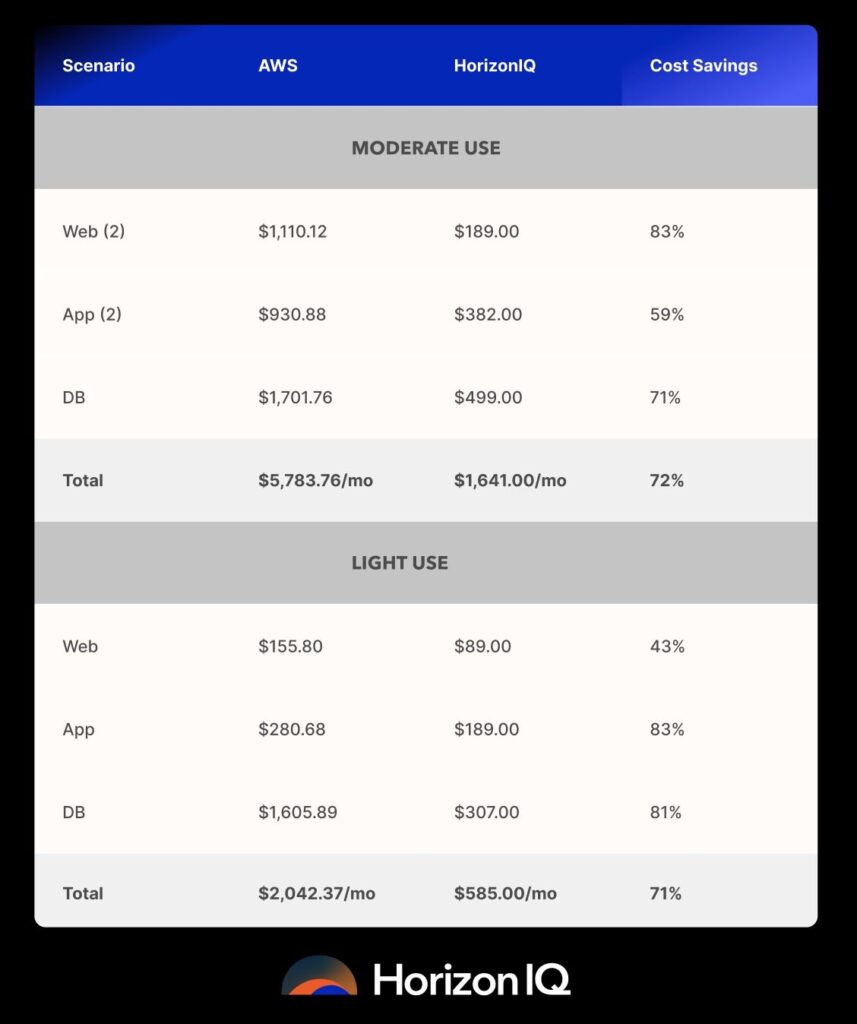
Why Are Companies Leaving the Cloud? A Closer Look at Repatriation
- Bare Metal | Cloud | Insights
The Rise of Companies Leaving the Cloud
As someone who’s witnessed the evolution of cloud computing firsthand, I have an interesting perspective on why companies are increasingly choosing to move their workloads back on-premises.
This shift, often called “cloud repatriation,” is driven by several critical factors causing many organizations to adjust their cloud strategy.
Let’s explore why this trend is gaining momentum, the reasons behind this significant shift in IT infrastructure, and how bare metal can bridge the gap between public cloud and on-prem infrastructure.
The Promise of the Cloud vs. Reality
The initial promise of the cloud was enticing: lower costs, greater agility, and enhanced innovation. For a while, it seemed like the perfect solution for modern businesses. However, as more companies adopted cloud services, the reality began to diverge from the promise.
-
Cost Concerns
One of the primary reasons for cloud repatriation is cost. According to a survey by Citrix, 43% of IT leaders found that moving applications and data to the cloud was more expensive than expected.
The allure of lower upfront costs often masks the ongoing expenses of cloud services. Businesses quickly realize that the pay-as-you-go model can lead to unexpected and exorbitant bills.
The cost issue becomes even more pronounced for traditional enterprise workloads that haven’t been optimized for the cloud. These workloads often result in higher operational costs without delivering the anticipated benefits of agility and innovation.
For example, companies like Basecamp reported spending $3.2 million on cloud services in a year, only to find they could save significantly by moving back to on-premises solutions.
-
Security Concerns
Security is another major factor driving companies away from the cloud. The Citrix survey highlighted that 33% of organizations cited security issues as a motivator for cloud repatriation.
Despite the security measures implemented by cloud providers, many businesses feel more secure managing their own infrastructure. This sense of control over data and security protocols is particularly crucial for industries dealing with sensitive information, such as finance and healthcare.
-
Unmet Expectations
Unmet expectations are a recurring theme in technology trends. The cloud is no exception. The same Citrix survey revealed that 24% of respondents were motivated by the failure to meet internal expectations.
Companies often expect seamless integration, enhanced performance, and lower costs—only to find that these expectations are not always met. Performance issues, compatibility problems, and service downtime further exacerbate the dissatisfaction with cloud services.
Looking to migrate without overlap costs?
Migration shouldn’t drain your budget. With HorizonIQ’s 2 Months Free, you can move workloads, skip the overlap bills, and gain extra time to switch providers without double paying.
Get 2 Months FreeWhat Companies are Leaving the Cloud?
-
Basecamp
The well-known project management software company, Basecamp, made headlines when it decided to move most of its workloads off of AWS and GCP and onto its own infrastructure housed in a colocation facility. Basecamp reported that it could save millions by leaving the cloud.

David Heinemeier Hansson, CTO of Basecamp, argued that their predictable workload and capable team made on-premises a more cost-effective solution. This move highlights the importance of assessing the specific needs and capabilities of an organization before committing to cloud services.
-
Dropbox
Dropbox is another high-profile example of companies leaving the cloud. The company moved 90% of its data from the cloud to its own data centers. By doing so, Dropbox claimed to save nearly $75 million over two years.
This decision was driven by the need for greater control over their infrastructure and the realization that their specific requirements could be better met with on-premises solutions.
What Are the Technical Challenges with Cloud Repatriation?
-
Data Egress Fees
One of the primary concerns with public cloud environments is the cost of transferring data out, often referred to as data egress fees.
While tools like Microsoft’s Azure ExpressRoute or other direct connections can mitigate these expenses, particularly in hybrid models or temporary data migration scenarios, they do introduce added complexity.
-
Architectural Refactoring
Moving away from vendor-specific services in the public cloud often necessitates significant architectural changes and refactoring.
Applications built on serverless or highly cloud-centric designs may require substantial re-engineering to function optimally on on-prem or bare metal infrastructure. This can lead to unexpected performance bottlenecks, especially if organizations have become reliant on the cloud provider’s backend optimizations.
-
Skills Gap
Cloud repatriation may expose gaps in an organization’s technical skill set.
Teams accustomed to the cloud’s managed services might lack experience in areas like database replication, clustering, or even understanding operating system intricacies. Such deficiencies can prolong migration timelines and increase the risk of costly errors.
-
Downtime
Migrating live applications while minimizing downtime is a complex undertaking, even between identical environments.
The architectural changes inherent in cloud repatriation amplify this challenge. It’s crucial for technical teams to meticulously plan and execute the migration process to avoid disruptions to business operations.
Is the Public Cloud Right for Your Business?
While cloud repatriation offers numerous advantages, the public cloud is not without its merits and may be the right choice for some companies.
Businesses with variable workloads, such as startups, benefit from the scalability and flexibility of the public cloud. The pay-as-you-go pricing model allows them to scale resources up or down as needed without committing to long-term contracts or investing heavily in infrastructure upfront.
Companies that operate in sectors with rapid development cycles, such as software development and testing, often find the public cloud advantageous. The ability to quickly provision and decommission resources aligns well with their agile methodologies, allowing for faster time-to-market and efficient use of resources during peak development periods.
Global enterprises that require extensive geographic reach to serve customers benefit from the global infrastructure of public cloud providers.
While the cloud can be highly beneficial for these businesses, HorizonIQ’s single-tenant bare metal servers offer a compelling alternative for those seeking predictable costs, consistent performance, enhanced security, and substantial financial savings.
Our customers who have made the switch are enjoying these benefits, freeing their IT budgets for innovation and growth while avoiding the constraints and hidden costs of public cloud environments.
What Are the Cost Savings with Bare Metal vs Public Cloud?
Bare metal bridges the gap between public cloud and on-premises. It offers the performance, security, and customization benefits of on-premises with the scalability and reduced operational overhead of the cloud.
For example, we’ve witnessed running a realistic moderate-duty site with a configuration of two web servers, two application servers, and one database server, would cost approximately $5,783.76 with AWS.
By switching to HorizonIQ bare metal servers, the cost would drop to $1,641.00 per month, yielding an impressive 72% savings. Even for lighter use cases, our customers typically see savings of over 70% compared to public cloud costs.

What is the Future of Cloud Computing?
Despite the challenges, the cloud is not going away. Cloud providers continue to innovate and offer new services that address some of the concerns raised by businesses.
For example, the rise of hybrid cloud solutions allows companies to enjoy the benefits of cloud and on-premises infrastructure. Organizations employing containerized solutions like Docker and Kubernetes often find it easier to transition due to their inherent portability.
Hybrid environments, where on-premises infrastructure is augmented by public cloud resources for peak demand or unexpected loads, can also prove advantageous.
When combined with direct connections like ExpressRoute, such setups can reduce data transfer costs and provide greater flexibility.
How Will AI Change the Cloud Landscape?
AI-driven analytics will enable more effective decision-making through predictive insights. The rise of AI-as-a-Service (AIaaS) will also democratize access to advanced AI tools, allowing businesses to integrate sophisticated machine learning models and other AI technologies without needing extensive in-house expertise.
However, some companies may opt for bare metal servers instead of virtualized cloud environments due to the need for maximum security, compliance performance, and control.
AI workloads, particularly those involving deep learning and large-scale neural network training, benefit from the dedicated hardware and low latency that bare metal servers provide.
This setup allows for greater hardware customization, enabling organizations to tailor their infrastructure to specific AI workload requirements, such as optimizing for GPU performance or high-speed interconnects.
Make Informed Decisions Before Leaving the Cloud
The decision for companies to leave the cloud is not one to be taken lightly. It requires a thorough analysis of the specific needs and capabilities of an organization. Businesses must weigh the costs, security implications, and performance requirements of their workloads.
In some cases, moving back to on-premises or single-tenant bare metal infrastructure may be the right choice. In others, optimizing cloud usage or adopting a hybrid approach may offer the best solution.
Ultimately, the key is to make informed decisions based on a clear understanding of the benefits and limitations of cloud computing. By doing so, your business can ensure you’re getting the most value from your IT investments.
So, is leaving the cloud the right choice for your company?
It depends on your circumstances. Evaluate your needs, consider the pros and cons, and make a decision that aligns with your business goals.
And remember, like most technologies, the landscape of cloud computing is continually evolving. With every new offering—opportunities and challenges will require ongoing assessment and adaptation.
If you’re interested in learning more about cloud repatriation, reach out to our team and we’ll be happy to provide you with the information you need to make an informed decision.



